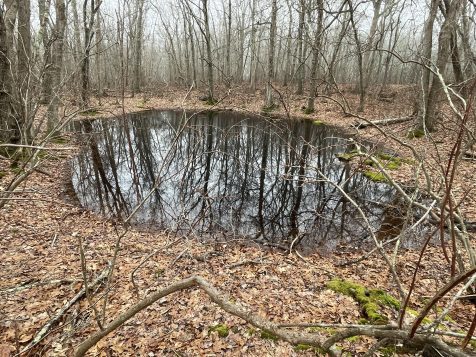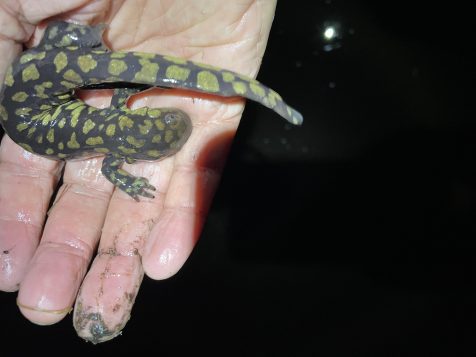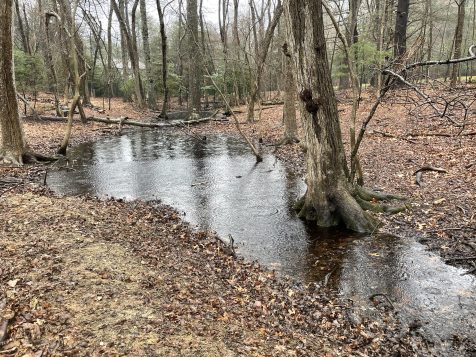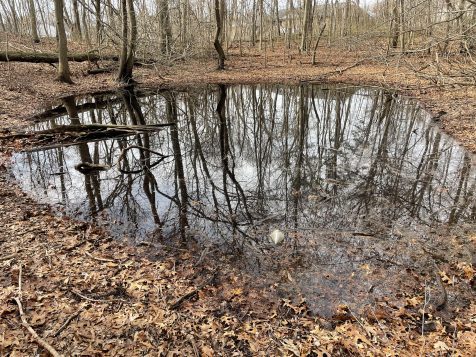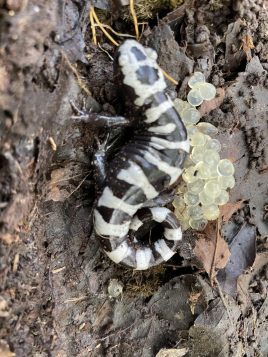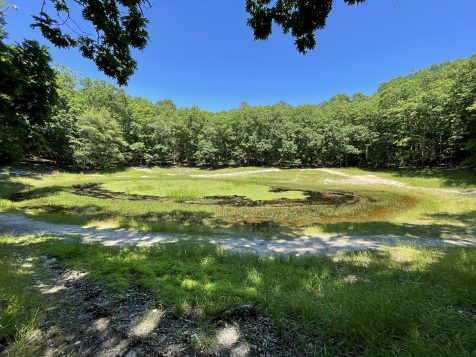By John L. Turner

They are quite easy to overlook. Most are small, some really small, the size of your living room. Or maybe no bigger than the size of the first floor of your house. They are typically dry by the time summer’s heat reaches full blast so if you’re not trained to look at a shallow depression of water stained leaves you may not know what you’re looking at — a dynamic ecosystem that when filled with water sustains scores of species.
These habitats, just dimples in the landscape, are known as vernal pools, or as a key researcher from the Massachusetts-based Vernal Pool Association likes to call them, “wicked little puddles.” They are fascinating small-scale ecosystems filled with wonder and discovery.
Vernal pools gain their name because generally they have their highest water levels in the spring, around the vernal equinox, due to the combination of seasonal rains and snow melt. Amphibians are the stars of the vernal pool show, taking advantage of these fishless environments allowing them to breed successfully. Three of the more common Long Island amphibians utilizing these pools are Wood Frogs, Spring Peepers, and Spotted Salamanders.
Beginning in the middle of March, unless it’s a harsh winter, these species emerge from their upland overwintering sites (under logs, in rodent holes, etc.) and migrate to the ponds to make the next generation. Visiting a pool on a spring night it is not unusual to hear the deafening peeps of the Peepers (living up to their name) and the vocalizations of wood frogs (a cross between the quack of a duck and the barking of a dog).
Shine a flashlight on the water and you might see the tail swish of a beautiful yellow-dotted Spotted Salamander moving through the leaves lining the pond’s bottom. Or perhaps it will be cork-like creatures in the form of mating pairs of wood frogs in amplexus — she releases dozens to more than a hundred eggs into the water quickly followed by the clasping male releasing a cloud of sperm. Soon, the gelatinous egg mass swells with water, forming fist size clusters, anchored to submerged stems and over the next couple of weeks the embryos develop, eventually hatching into tadpoles.
Spotted Salamander egg masses look similar but in their case fertilization is internal with the female taking up sperm capsules (called spermatophores) which the male salamanders have deposited on the pool bottom. Spring peepers, a species of treefrog, don’t lay egg clusters like these other two species but rather deposit individual eggs.
Other amphibians known to use Long Island vernal pools include cousins to the Spotted Salamander: Marbled, Blue-spotted and Eastern Tiger Salamanders (a New York State endangered species), Red-spotted Newts, Fowler’s and Eastern Spadefoot Toads, Grey Treefrogs, and to a lesser extent American Bullfrogs, and Pickerel and Green Frogs.
Many other forms of life thrive in these “wicked little puddles.” One fascinating species are fairy shrimp, small krill-like crustaceans that swim about the water column “upside down” with females carrying egg clusters in their tail appendage. We have two species on Long Island, both of which are quite adept at surviving prolonged dry periods even when vernal pools remain dry for several consecutive years, such as during a drought.
How does a fairy shrimp survive prolonged dry periods? Their eggs are cyst like and can tolerate complete desiccation, extreme cold, harsh UV exposure, and other extreme environmental conditions and come out of it no worse for the wear — they are the definition of tough! The eggs are even known to travel through the digestive system of ducks (several species of waterfowl routinely feed on fairy shrimp), unscathed by the bird’s digestive acids and it is thought this pathway explains how shrimp colonize new pools.
Many other types of invertebrates frequent vernal pools including quite a few types of water bugs and beetles, midges, mites, and mosquitoes, dragonflies and damselflies, worms, snails and clams, copepods, all tied together with amphibians and other vertebrates in a complex food web of “eat and be eaten”.
For many vernal pool inhabitants, including amphibians, there is a clock always ticking, as animals speed to complete stages of their life cycle before the pools dry up, certain death for tadpoles that have not yet completed metamorphosis. Some eggs hatch as quickly as a couple of days and tadpoles can undergo the miracle of metamorphosis in a few weeks. Some grow more rapidly by dining on the aforementioned fairy shrimp which is a plentiful source of protein in the pool.
For these vernal pool frequenting amphibians to survive, it is not enough to protect just the pool and pool basin. Wood Frogs, Spotted Salamanders and many other amphibians migrate from the pools once breeding is done to spend the rest of the year in adjacent upland habitats around the pools. “Around” is a relative term as it may involve distances of several hundred feet since some individuals travel far (a few individuals such as Tiger Salamanders and Wood Frogs have been documented moving more than a thousand feet from the pool). Thus, protecting upland habitats around vernal pools is vital. Protecting upland areas between pools is ideal!
In 2022 a coalition of environmental groups worked with the NYSDEC and the Governor’s office to amend the NYS Freshwater Wetlands Act, strengthening it in many ways including providing greater protection for vernal pools. This effort paid off as vernal pools are included as one of eleven new categories of “‘wetlands of unusual importance” which provides them protection. Good thing as countless of these tiny to small, but amphibian-essential, pools, which are sometimes dry, have been destroyed, having been filled in and leveled for development.
Through funding from the Long Island Community Foundation (as it was known at the time; now it’s the New York Community Trust), the Seatuck Environmental Association undertook, with many other individuals and organizations through the framework of “Vernal Pool Working Group,” an island-wide effort to locate and characterize all of the vernal pools situated on Long Island.
Now completed, this project has identified about 350 pools from Queens to the west and the Montauk peninsula to the east. A second phase of the project included the publication of a Landowner’s Guide to Vernal Pool Management providing recommendations for public and private property owners to better manage and protect their vernal pools and the species that utilize them.
One recommendation is to leave branches in the pond that have fallen in as they often are used by salamanders and frogs for sites to anchor their egg masses. Another is if your house has a basement with window wells to put covers over the wells to prevent amphibians from falling in. Several years ago I rescued a tiger salamander from a house in Ridge that had fallen into just such a well, where it ultimately would have perished if left alone.
Vernal pools are fascinating places to explore — little microcosms of ecosystems. They are truly “wicked little puddles,” beautiful and fascinating places in which to connect and explore the natural world that surrounds us all. I hope you find time to visit one.
A resident of Setauket, author John L. Turner is a naturalist, conservation co-chair of the Four Harbors Audubon Society, and Conservation Policy Advocate for the Seatuck Environmental Association.

